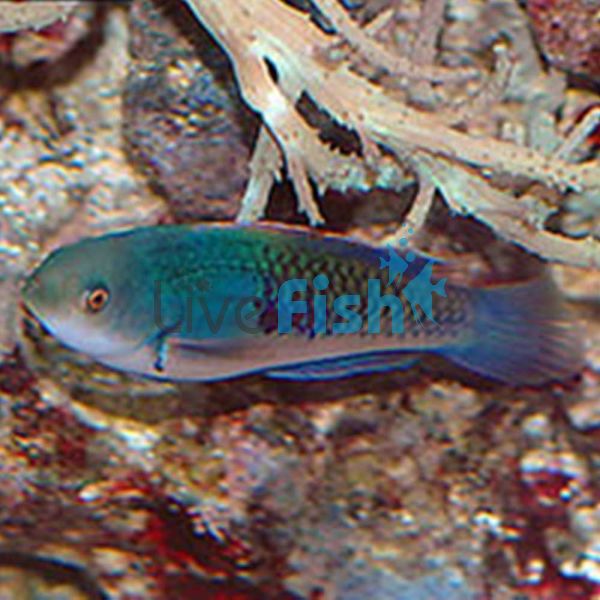Blueside Fairy Wrasse - Medium
These small but incredibly active fish will spend most of their time cruising around the tank looking for food. With their bright colours and generally passive nature, they are a great addition to any tank.
Blueside Fairy Wrasse
These fish have a round blue and olive green coloured head with darker purple scales towards the back of the body combined with a lighter belly and red tail fin. The females of the species are browner, smaller and show pale spots along the body. The colouration and patterning of the males can vary depending on where exactly they have come from.
The species of wrasse is extremely challenging to breed in captivity. In the wild eggs are scattered and allowed to drift in the water column until settling back onto the reef in a different area.
It's extremely fun to watch these little guys pop up and down in the aquarium due to their ability to scull their fins, but be careful, they are accomplished jumpers and can easily be lost over the side in an uncovered tank.
The Blueside fairy wrasse is found from depths of 2-30 meters in rock and coral reefs all around the Indo East-West Pacific region from the Andaman Sea to the Great Barrier Reef.
Tank Recommendations for Blueside Fairy Wrasse
The smallest tank size for the Blueside Fairy Wrasse is 210 liters. These fish need plenty of swimming room as they are extremely active but make sure you include plenty of places to shelter so that they can acclimatize. They have been sometimes known to enjoy living in the tentacles of stony coral.
As mentioned before it is a must that these fish are housed in a covered tank because of the active lifestyle they can easily swim themselves out and over the top of an aquarium.
Make sure to have a moderately deep sand bed which the fish will use to bury themselves into sleep at night.
Suitable Tank Buddies
The Blueside Fairy Wrasse are usually peaceful with most of their tank buddies however care should be taken with other similar and same species of wrasse. It's a great idea to pair one male with several females to stop their striking colour patterns from fading and becoming dull. As these are shy and docile fish avoid keeping them with larger more aggressive ones.
Usually Compatible
Damsels, tangs, and angelfish make good tank buddies with the Blueside Fairy Wrasse. They have been known to get along well with boxfish also. Females of the same species are the preferred choice.
Sometime Compatible
Blennies, Clownfish, Dwarf Angelfish, and Frogfish can also be housed with these fish, but caution must be taken. You must also watch for signs of aggression with species such as Dragonettes, Parrotfish, Goatfish, and Gobies. Groupers, Triggerfish, and Snappers may also show aggressive behavior so keep an eye out. It is sometimes possible to house with other types of wrasse as long as they don't look too similar.
Rarely Compatible
Although Blueside Fairy Wrasse is generally quite docile fish they could leave slower moving fish such as Seahorses and Pipefish without food. This species should not be housed with other males of the same species and Sharks will most certainly eat them.
Feeding Your Blueside Fairy Wrasse
These fish are carnivorous and will thrive on a diet of frozen and flake foods but make sure it's varied and of high quality, if you want your fish looking its best. Meaty foods such as mysis and brine shrimp will be great. Feed them small amounts, several times a day.
| Scientific Name | Cirrhilabrus Cyanopleura |
|---|---|
| Care Level | Moderate |
| Common Names | The Blueside Fairy Wrasse, is also known as the Yellow Flanked Fairy Wrasse and the Blue Scaled Fairy Wrasse. |
| Diet | Carnivore |
| Fish Family | Labridae |
| Lifespan (years) | 4 |
| Max. Length (cm) | 13 |
| Min. Tank Volume (l) | 210 |
| Origin | Indo-Pacific |
| Reef Safe | Yes |
| Sociability | Peaceful |
| Venomous | No |
| Water Conditions | 24-28° C (75-82° F), dKH 8-12, pH 8.1-8.4, sg 1.020-1.025 |




